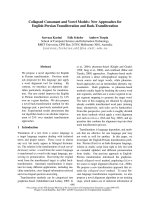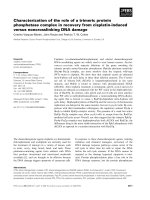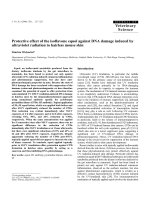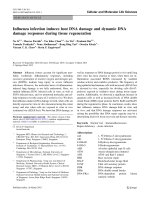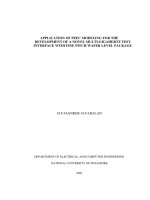DEVELOPMENT AND APPLICATION OF NEW APPROACHES FOR STUDIES OF INFLUENZA INDUCED INFLAMMATION AND DNA DAMAGE
Bạn đang xem bản rút gọn của tài liệu. Xem và tải ngay bản đầy đủ của tài liệu tại đây (8.71 MB, 223 trang )
DEVELOPMENT AND APPLICATION OF NEW APPROACHES FOR STUDIES
OF INFLUENZA-INDUCED INFLAMMATION AND
DNA DAMAGE
Li Na
B.Sc. (Hons), NUS
A THESIS SUBMITTED FOR THE
DEGREE OF DOCTOR OF PHILOSOPHY IN SCIENCE
DEPARTMENT OF MICROBIOLOGY
YONG LOO LIN SCHOOL OF MEDICINE
NATIONAL UNIVERSITY OF SINGAPORE
2015
1
i.
Declaration:
I hereby declare that the thesis is my original work and it has been written by me
in its entirety. I have duly acknowledged all the sources of information which
have been used in the thesis. This thesis has not been submitted for any degree
in any university previously.
_______________________
Li Na
i
ii.
Acknowledgements:
First and foremost, I would like to express my sincere gratitude to my supervisors
Professor Bevin Engelward and Professor Vincent Chow, for offering me the
opportunity to be a part of their labs, for their intellectual and moral support, for
their inspiration in doing good science, and for teaching me how to present myself
and my work. I would like to show my appreciation to my thesis advisory committee
members Professor Fred Wong and Professor Marie Clement for their invaluable
comments and suggestions for my thesis, and to my collaborators, Dr Damien
Thévenin and Professor Donald Engelman.
Many thanks to my lab mates and colleagues in Singapore – Dr Yamada Yoshiyuki,
Prashant, Tze Khee, Kai Sen, Anandi and Dr Orsolya Kiraly- for lending me
support in my projects, for giving me constructive suggestions, and most of all, for
your friendship. I will like to specially mention my appreciation towards Dr Yamada,
who had mentored me for 3 years and had taught me useful skills and good lab
practices. In addition, my project would not have been possible if not for Mrs Phoon
who painstakingly propagated all the viruses. To my lab mates in MIT- Marcus,
Jenny, Shelly, Lizzie, Yang Su, Jing- thank you for being such wonderful
colleagues and for the good scientific exchanges we have had. To all my SMART
friends, the “Aunties of SMART”, the lung repair group, and my fellow SMA3
students, thank you for being great colleagues and amazing friends too, making
my time in SMART an extremely enjoyable one. I am going to miss you guys!
And most importantly, I would like to thank my parents for believing in me and for
being my pillar of support. And last but not least, to my boyfriend, for being there
with me, always, to listen, to share, to advice and to empathize. Thank you all for
ii
giving me the strength, courage and wisdom needed to complete this long and
demanding journey.
Some passages and images in chapter 2 and chapter 4 are quoted verbatim or
reprinted from “Na Li, Yin Lu, Thevenin Damien, Yamada Yoshiyuki, Limmon Gino,
et al. (2013) Peptide targeting and imaging of damaged lung tissue in influenzainfected mice. Future Microbiol 8: 257-269.” with permission from Future
Microbiology.
Some passages and images from chapter 2 and chapter 5 are quoted and
reprinted from “Sukup-Jackson R. Michelle, Kiraly Orsolya, Kay Jennifer, Na Li,
Rowland, Kelly E. Winther Elizabeth A., Chow Danielle N., Kimoto Takafumi,
Matsuguchi Tetsuya, Jonnalagadda Vidya S., Maklakova Vilena I., Singh Vijay R.,
Wadduwage Dushan N., Rajapakse Jagath, So Peter T. C., Collier Lara S.,
Engelward Bevin P. (2014) Rosa26-GFP direct repeat (RaDR-GFP) mice reveal
tissue- and age-dependence of homologous recombination in mammals in vivo.
PLoS Genet 10: e1004299.” PLoS Genetics is an open-access journal, so no
permission from the publisher was needed for using the materials. Passages
quoted in this thesis were contributed to the journal by the author of this thesis.
iii
iii.
Funding:
This thesis is supported by the Singapore National Research Foundation (NRF),
Ministry of Education (MOE) and in part by the National Institute of Environmental
Health Sciences (P01-ES006052). The views expressed herein are solely the
responsibility of the author and do not necessarily represent the official views of
the funding bodies.
iv
iv.
Publications:
Yoshiyuki Yamada, Gino V. Limmon, Dahai Zheng, Na Li, Liang Li, Lu Yin, Vincent
T. K. Chow, Jianzhu Chen, Bevin P. Engelward. (2012) Major shifts in the spatiotemporal distribution of lung antioxidant enzymes during influenza pneumonia.
PLoS One 7: e31494.
Na Li, Lu Yin, Damien Thévenin, Yoshiyuki Yamada, Gino Limmon, Jianzhu Chen,
Vincent TK Chow, Donald M Engelman, Bevin P Engelward. (2013) Peptide
targeting and imaging of damaged lung tissue in influenza-infected mice. Future
Microbiol
8:
257-269.
Sukup-Jackson R. Michelle, Kiraly Orsolya, Kay Jennifer, Na Li, Rowland, Kelly E.
Winther Elizabeth A., Chow Danielle N., Kimoto Takafumi, Matsuguchi Tetsuya,
Jonnalagadda Vidya S., Maklakova Vilena I., Singh Vijay R., Wadduwage Dushan
N., Rajapakse Jagath, So Peter T. C., Collier Lara S., Engelward Bevin P. (2014)
Rosa26-GFP direct repeat (RaDR-GFP) mice reveal tissue- and age-dependence
of homologous recombination in mammals in vivo. PLoS Genet 10: e1004299.
Na Li, Marcus Parrish, Tze Khee Chan, Lu Yin, Prashant Rai, Yamada Yoshiyuki,
Nona Abolhassani, Kong Bing Tan, Orsolya Kiraly, Vincent T. K. Chow, Bevin P.
Engelward. Influenza infection induces host DNA damage and dynamic DNA
damage responses during tissue regeneration. Cell Mol Life Sci. 2015 Mar 26.
[Epub ahead of print]
v
v.
Conference Abstracts:
Na Li, Liang Li, Damien Thévenin, Yoshiyuki Yamada, Yin Lu, Gino Limmon,
Vincent TK Chow, Donald M Engelman, Bevin P Engelward. Peptide targeting
and imaging of damaged lung tissue in influenza-infected mice. Poster session
presented at: Asia- Pacific Congress of Medical Virology; 2012, 6-8 June;
Adelaide, Australia.
Na Li, Damien Thévenin, Liang Li, Yoshiyuki Yamada, Yin Lu, Gino Limmon,
Vincent TK Chow, Donald M Engelman, Bevin P Engelward. Peptide targeting
and imaging of damaged lung tissue in influenza-infected mice. Poster session
presented at: Singapore - Japan Joint Forum On Emerging Concepts In
Microbiology; 2011, 15-16 November; Singapore.
vi
vi.
Abbreviations:
5’-dRP
53BP1
8-OH-G / 8-OH-dG
ALI
ARDS
AEI/ AEII
ATM
AP
BALF
BER
CCSP
CI
DBD
DDR
DNA
DNA-PK
DNA-PKcs
dpi
DSBs
H&E
H2O2
5’- deoxyribose phosphate
p53 Binding Protein 1
8-hydroxyguanosine/ 8-hydroxy-deoxyguanosine
Acute lung injury
Acute respiratory distress syndrome
Alveolar epithelial type I/II cells
Ataxia telangiectasia mutated
Apurinic / apyrimidinic
Bronchoalveolar lavage fluid
Base excision repair
Club cell secretary protein
Contrast index
DNA binding domain
DNA damage response
Deoxyribonucleic acids
DNA- dependent protein kinase
DNA- dependent protein kinase catalytic subunit
days post infection
DNA double strand breaks
Hematoxylin and eosin
Hydrogen peroxide
HA
HOCl
hpi
HR
HRP
iNOS
M1/ M2
MDCK cells
NA
NAD+
NHEJ
NO
NP
NS1/ NS2
NSAIDs
NU7441
O2−•
Haemagglutinin
Hypochlorous acid
hours post infection
Homologous recombination
Horse radish peroxidase
Inducible nitric oxide synthase
Matrix1/2
Madin-Darby canine kidney cells
Neuraminidase
Nicotinamide adenine dinucleotide
Non-homologous end joining
Nitric oxide
Nucleoprotein
Non-structural protein 1/ Non-structural protein 2
Non-steriodal anti-inflammatory drugs
2-N-morpholino-8-dibenzothiophenyl-chromen-4-one
Superoxide
ONOOPA/ PB1/ PB2
PAR
Peroxynitrite
Polymerase A/ B1/ B2
Poly (ADP-ribose)
vii
PARP-1
PCNA
Pdpn
PEG
PFU
pHLIP
PIKK
RaDR-GFP
PR8
Prdx6
Pro-SPC
RdRp
ROI
ROS/RNS
SOD
TNF-α
TUNEL
XO
Poly (ADP-ribose) polymerase 1
Proliferating cell nuclear antigen
Podoplanin
Polyethylene glycol
Plaque forming units
pH (Low) insertion peptide
Phophatidylinositol-3-kinase-like kinases
Rosa26 Direct Repeat-Green Fluorescent Protein
Influenza A/Peurto Rico/8/34
Peroxiredoxin 6
Pro- surfactant protein C
RNA-dependent RNA polymerase
Region of interest
Reactive oxygen and nitrogen species
Superoxide dismutase
Tumour necrosis factor-alpha
Terminal deoxynucleotidyl transferase dUTP nick end labeling
Xanthine oxidase
viii
TABLE OF CONTENTS
I.
DECLARATION: ........................................................................................... I
II.
ACKNOWLEDGEMENTS: ........................................................................... II
III. FUNDING: ...................................................................................................IV
IV. PUBLICATIONS: .........................................................................................V
V.
CONFERENCE ABSTRACTS: ...................................................................VI
VI. ABBREVIATIONS: ....................................................................................VII
TABLE OF CONTENTS .....................................................................................IX
SUMMARY .......................................................................................................... 1
LIST OF FIGURES .............................................................................................. 4
LIST OF TABLES ............................................................................................... 7
CHAPTER 1 BACKGROUND ............................................................................. 8
1.1
Influenza virus ......................................................................................... 8
1.1.1
1.1.2
1.1.3
1.2
Influenza infection induces acute lung injury ..................................... 19
1.2.1
1.2.2
1.2.3
1.3
Cellular responses towards DNA damage ..............................................29
Base excision repair removes damaged bases ......................................30
DNA damage can arise from BER intermediates ....................................32
DNA double strand break (DSBs) repair .................................................33
Studying significance of DNA repair pathway in vivo ........................ 37
1.4.1
1.5
Influenza-induced cytopathy and lung injury .........................................20
Inflammatory responses and lung injury ................................................20
Reactive oxygen and nitrogen species during influenza infection........21
ROS and RNS can damage genomic DNA........................................... 26
1.3.1
1.3.2
1.3.3
1.3.4
1.4
Life cycle of Influenza virus.....................................................................10
Antigenic drift and antigenic shift ...........................................................14
Global burden imposed by influenza outbreaks.....................................17
Genetically engineered mouse that enable visualization of HR events 38
Improving biodistribution of therapeutic agents ................................ 39
1.5.1
Targeting inflamed tissue with pH sensitive peptide .............................39
ix
1.6
Thesis aims ........................................................................................... 41
CHAPTER 2 METHODS AND MATERIALS ..................................................... 42
2.1
Materials ................................................................................................ 42
2.1.1
2.1.2
2.1.3
2.1.4
2.1.5
2.1.6
2.2
Media, chemicals and reagents ...............................................................42
Cell cultures .............................................................................................43
List of antibodies for western blot and immunofluorescence ...............44
List of antibodies for flow cytometry ......................................................45
Source of influenza viruses .....................................................................45
pHLIP and pHLIP variant peptide sequences and conjugation .............46
Methods and protocols......................................................................... 47
2.2.1
Infection of mice and tissue collection ..................................................47
2.2.2
Lung homogenization and virus titration................................................48
2.2.3
Lung histology, infiltration index calculation and pathology analysis..48
2.2.4
Measurement of ROS markers and TNF-α ..............................................49
2.2.5
Western blotting.......................................................................................50
2.2.6
Flow cytometry of immune cells .............................................................50
2.2.7
Immunofluorescence assay ....................................................................51
2.2.8
Microscopy...............................................................................................52
2.2.9
Manual and semi-automated quantification of H2AX foci.....................53
2.2.10
Terminal deoxynucleotidyl transferase dUTP nick end labeling (TUNEL)
and quantification ...................................................................................................54
2.2.11
Microarray data analysis .........................................................................55
2.2.12
NU7441 treatment of infected mice .........................................................56
2.2.13
RaDR mice and single cell suspension preparation ..............................56
2.2.14
RaDR cells RNA extraction and cDNA conversion .................................57
2.2.15
Direct PCR analysis using RNA transcripts............................................58
2.2.16
Nested PCR analysis for Full-length EGFP.............................................59
2.2.18
In vitro experiment with pHLIP ................................................................62
2.2.19
Peptide injection in mice .........................................................................62
2.2.20
Whole body and ex vivo whole organ bioimaging..................................62
2.2.21
Feature extraction and pHLIP quantification ..........................................63
2.2.22
Statistical analysis ...................................................................................65
CHAPTER 3 INFLUENZA INFECTION INDUCES DNA DAMAGE AND
ROBUST DNA DAMAGE RESPONSES IN VIVO ............................................. 66
3.1
Introduction ........................................................................................... 66
3.1.1
Investigation of DNA damage as a potential mechanism of influenza
pathogenesis ...........................................................................................................66
3.1.2
Phosphorylation of H2AX (Ser-139) during DNA strand breaks ............69
3.1.3
DNA damage is triggered by influenza infection in vitro .......................72
3.1.4
Aims of study ...........................................................................................74
3.2
Results................................................................................................... 76
3.2.1
Characterization of H1N1 murine model .................................................76
3.2.2
Prolonged inflammation after suppression of virus load.......................76
3.2.3
Broad characterization of pulmonary inflammation ...............................81
3.2.4
Oxidative stress is elevated during infection .........................................84
3.2.5
Host responses induce DNA damage in lung epithelium after influenza
infection 86
3.2.6
DNA damage occurs in immune cell populations ..................................94
x
3.2.7
Influenza infection induces polymerization of poly (ADP- ribose) ........96
3.2.8
Influenza infection leads to apoptosis ....................................................99
3.2.9
Infection increases DNA damage among dividing cells.......................102
3.2.10
Influenza infection induces DSB repair proteins during tissue
regeneration ..........................................................................................................105
3.2.11
NHEJ component, DNA-PK, is dispensable for DNA repair during tissue
regeneration ..........................................................................................................109
3.3
Discussion........................................................................................... 113
3.4
Conclusion .......................................................................................... 120
3.5
Future studies ..................................................................................... 121
3.5.1
3.5.2
Verification of forms of DNA damage ...................................................121
DNA repair deficiencies on cell fate and disease outcome..................122
CHAPTER 4 FLUORESCENT DETECTION OF HOMOLOGOUS
RECOMBINATION EVENTS FOLLOWING INFLUENZA INFECTION ........... 124
4.1 Introduction ............................................................................................. 124
4.1.1
4.1.2
4.1.3
4.2
Results and Discussion...................................................................... 131
4.2.1
4.2.2
4.2.3
4.2.4
4.3
Homologous recombination ..................................................................124
Approach for studying HR during influenza infection in vivo..............125
Aims of Study.........................................................................................129
PCR-based analysis of cDNA ................................................................131
Improved sensitivity with nested PCR ..................................................132
PCR analysis of HR mechanism in single cells ....................................136
EGFP expression to monitor HR events in lung epithelial cells ..........140
Conclusion and Future studies.......................................................... 143
CHAPTER 5 IMAGING AND TARGETING OF PH (LOW) INSERTION PEPTIDE
(PHLIP) AT INFLAMED LUNG TISSUE DURING INFLUENZA INFECTION .. 144
5.1
Introduction ......................................................................................... 144
5.1.1
5.1.2
5.1.3
5.1.4
5.1.5
5.2
Targeted drug delivery as a therapeutic strategy.................................144
pHLIP: pH (low) insertion peptide .........................................................147
Inflammation changes pH of tissue microenvironment .......................151
Aims of study .........................................................................................152
Specific aims ..........................................................................................153
Results................................................................................................. 154
5.2.1
5.2.2
5.2.3
organs
5.2.4
5.2.5
5.2.6
5.2.7
5.2.8
pHLIP targets influenza-infected lungs.................................................154
pHLIP also targets other acidic tissue ..................................................156
pHLIP has high retention in inflamed lungs as compared to other
158
Design of pHLIP variants .......................................................................160
Evidence of pH-dependent pHLIP accumulation in infected lungs .....165
pHLIP accumulates in regions of lungs with heavy cellular infiltration
168
pHLIP colocalizes with damaged lung tissue .......................................172
pHLIP-targeted lung parenchyma has diminished antioxidant............175
xi
5.3
Discussion........................................................................................... 177
5.4
Conclusion .......................................................................................... 181
5.5
Future studies ..................................................................................... 181
5.5.1
pHLIP delivery of antioxidants ..............................................................181
CHAPTER 6 CONCLUSIONS ......................................................................... 183
REFERENCES: ............................................................................................... 188
xii
Summary
Influenza viruses are a group of highly contagious pathogens that account for
significant morbidity and mortality worldwide. Extensive studies have suggested
that dysregulated inflammatory responses including excessive production of
reactive oxygen and nitrogen species (ROS / RNS) mediate lung injury in severe
infections. However, underlying mechanisms and effective treatment strategies for
inflammation-induced injury are not fully established. The aims of this thesis have
been to broadly characterize an influenza-pneumonia mouse model, and to
examine the impact of influenza infection on host genomes using the mouse model.
Using the mouse model, the potential of a low pH targeting peptide as a delivery
agent that can be used to improve treatment for inflammation-induced lung injury
is also evaluated.
One of the known mechanisms for ROS / RNS-induced toxicity is the ability to
induce DNA lesions, which can lead to mutations and cell death. In the first study,
we investigated whether DNA damage, a potential consequence of inflammationinduced ROS / RNS, is associated with severe influenza pneumonia. Using
immunofluorescence techniques, we observed an increase in DNA damage,
revealed by modified histones that form DNA repair foci at the sites of DNA strand
breaks in the lung tissue of infected mice. DNA repair foci are induced in lung
epithelial cells and infiltrating immune cells for prolonged duration even after viral
clearance, suggesting that DNA damage is driven by inflammation. Notably, DNA
damage was observed in lung tissue especially during the tissue regenerative
phase of infection, when cell division occurs simultaneously with unresolved
inflammation. If unrepaired, toxic DNA lesions, such as DNA double strand breaks
(DSBs), can have dire consequences on cells, potentially leading to large scale
1
genetic rearrangements and cytotoxicity that can impede recovery process.
Results show that DSB repair proteins Ku70 / Ku86 and Rad51 are upregulated
during the later stage of infection, implicating DSB repair pathways in the resolution
of DNA damage during lung tissue recovery. Taken together, the data demonstrate
that DNA damage is associated with influenza pneumonia, and raise a possibility
that DNA repair capacity may be a determinant for tissue recovery.
While investigating disease mechanisms may set a foundation for identifying
therapeutic targets for severe influenza infection, more effective treatment may be
achieved by modifying delivery of existing treatments. Optimized drug delivery in
terms of dose and biodistribution are important challenges for treating
inflammation-induced lung injury during influenza infections. In the second part of
this thesis, we investigated whether pH (Low) Insertion Peptide™ (pHLIP™), a
peptide with high affinity for acidic microenvironments, can be used for specific
delivery of drugs or imaging agents in influenza patients. This study is designed
based on the understanding that inflamed tissue is acidic while healthy tissues are
slightly alkaline. To test our hypothesis that pHLIP localize at sites of inflammation,
fluorophore-conjugated pHLIP was injected into infected mice to track peptide
distribution in vivo. Results show that pHLIP specifically targets inflamed lung
during the later stage of infection, when severe pneumonia manifest. In addition,
pHLIP-targeted lung tissues are injured and devoid of alveolar type I (AEI) and
type II cells (AEII) that are found in healthy alveoli. Interestingly, pHLIP-targeted
lung tissue is also characterized by depletion of Peroxiredoxin 6 (Prdx6), an
enzymatic antioxidant abundantly expressed in the lung. Importantly, the specific
distribution of pHLIP in inflamed tissue opens up opportunities for the delivery of
pHLIP-drug conjugates to ameliorate lung injury. Taken together, the results
2
provide new insights into the molecular pathology of influenza pneumonia, and
offer opportunities to improve the management of influenza-induced lung disease
3
List of figures
Figure 1.1 Structure of an influenza virus. ..................................................... 10
Figure 1.2 The life cycle of influenza virus. .................................................... 11
Figure 1.3 Inflammation-induced ROS / RNS damages cellular molecules. . 25
Figure 1.4 Structures of modified nucleobases upon exposure to ROS /
RNS................................................................................................................... 28
Figure 1.5 Classical DNA double strand break repair pathways. .................. 36
Figure 3.1 PR8 infection of MDCK cells induced H2AX foci formation. ...... 73
Figure 3.2 Disease progression during sublethal PR8 infection................... 78
Figure 3.3 Characterization of inflammation kinetics. ................................... 83
Figure 3.4 Real-time PCR analysis of IFN- in lung homogenate. ................. 84
Figure 3.5 Oxidative stress is elevated especially when viral load is
suppressed. ..................................................................................................... 85
Figure 3.6 Reduction in superoxide dismutase (SOD) activity on 7 dpi. ...... 86
Figure 3.7 Western analysis of influenza antigen and H2AX. ...................... 87
Figure 3.8 DSB markers, H2AX and 53BP1 foci, were induced in
bronchiolar epithelium cells after active infection. ....................................... 89
Figure 3.9 H2AX foci were induced in alveolar epithelial type II cells in the
recovery phase of influenza infection. ........................................................... 91
Figure 3.10 Increased H2AX foci formation in both infected and uninfected
cells. ................................................................................................................. 92
Figure 3.11 Pan-nuclear H2AX is found in the same regions as cleaved
caspase 3 positive cells in sequential sections. ........................................... 93
Figure 3.12 H2AX foci formation increases in immune cells after
infection. .......................................................................................................... 95
Figure 3.13 PARP mediated PAR polymerization increases after infection . 97
Figure 3.14 PARP-1 is cleaved following influenza infection ........................ 99
Figure 3.15 DNA damage is initiated before, and proceeds after whole lung
apoptosis. ...................................................................................................... 101
4
Figure 3.16 H2AX phosphorylation increases in Ki-67+ cells after
infection. ........................................................................................................ 104
Figure 3.17 NHEJ and HR-related genes are induced during tissue
regeneration................................................................................................... 107
Figure 3.18 HR-related genes are induced during the later stage of
infection. ........................................................................................................ 108
Figure 3.19 DNA-PKcs activity is dispensable for DNA repair in bronchial
epithelium on 9 and 13 dpi............................................................................ 111
Figure 3.20 PR8 infected mice injected with 2 doses of NU7441 at 9 dpi. .. 112
Figure 4.1 RaDR-GFP HR substrate recombines to encode for full length
EGFP sequences. .......................................................................................... 127
Figure 4.2 PCR detection of HR that led to full length EGFP reconstitution in
RaDR-GFP pancreatic cells .......................................................................... 135
Figure 4.3 Single strand annealing does not reconstitute RaDR-GFP........ 136
Figure 4.4 RaDR-GFP substrate yields different recombination products
following gene conversion, sister chromatid exchange, and replication fork
repair. ............................................................................................................. 138
Figure 4.5 Nested PCR analysis of single cells could identify cells that had
undergone crossover associated-HR or gene conversion without
crossover. ...................................................................................................... 140
Figure 4.6 EGFP positive cells arise in the lung epithelial cells indicating HR
at Rosa26 locus ............................................................................................. 142
Figure 5.1 pHLIP peptide sequences. ........................................................... 147
Figure 5.2 pHLIP exists in 3 states and facilitates bidirection transport of
cargo molecules. ........................................................................................... 150
Figure 5.3 pHLIP preferentially binds cell membrane at acidic pH in vitro. 151
Figure 5.4 pHLIP targets infected but not uninfected mice lungs............... 155
Figure 5.5 pHLIP targets acidic tissue. ......................................................... 157
Figure 5.6 Bioimaging of pHLIP-induced fluorescence on mice ventral
surface to estimate peptide clearance. ........................................................ 159
Figure 5.7 pHLIP is retained in infected lungs 8 days post peptide
injection. ........................................................................................................ 160
Figure 5.8 K-pHLIP accumulates in infected lungs via pH-independent
mechanism..................................................................................................... 161
5
Figure 5.9 pH responsiveness of pHLIP variants, Leu26Gly, K-pHLIP and
D3K-pHLIP...................................................................................................... 164
Figure 5.10 Evidence of pH-dependent targeting of pHLIP and Leu26Gly. 167
Figure 5.11 pHLIP targets heavily infiltrated regions of lungs. ................... 170
Figure 5.12 pHLIP accumulates in lungs during the later phase of
infection. ........................................................................................................ 172
Figure 5.13 pHLIP accumulates in damaged lung tissue. ........................... 174
Figure 5.14 pHLIP localizes at lung tissue depleted of Prdx6. .................... 176
Figure 5.15 Quantification of pHLIP-induced pixels in Prdx6 positive and
negative regions. ........................................................................................... 177
6
List of tables
Table 1.1 Licensed influenza anti-viral agents ............................................... 16
Table 2.1 Commercial sources of media and reagents ................................. 42
Table 2.2 Formulations for solutions and buffers ......................................... 43
Table 2.3 Sources and clones of antibodies used ......................................... 44
Table 2.4 Panel 1 antibodies for myeloid cells .............................................. 45
Table 2.5 Panel 2 antibodies for lymphoid cells ............................................ 45
Table 2.6 Sequences and molecular weights of pHLIP and peptide
variants ............................................................................................................ 46
Table 2.7 Antigen retrieval methods ............................................................... 51
Table 2.8 Mean number of Ki-67+ and H2AX+ cells counted in 15 40x
magnified images ............................................................................................ 54
Table 2.9 PCR primers to specifically amplify full length EGFP, Δ3egfp, and
Δ5egfp. ............................................................................................................. 59
Table 2.10 External PCR primers designed to anneal upstream and
downstream of the EGFP coding sequence. ................................................. 60
Table 2.11 Thermal cycler conditions and product sizes. ............................. 60
Table 3.1 Summary of DNA damage in infectious diseases ......................... 68
Table 3.2 Interplay between viral infection and DDR pathway that is
independent of DNA damage .......................................................................... 69
Table 3.3 Pathology analysis of mice lung sections following PR8
infection. .......................................................................................................... 79
Table 5.1 Anti-inflammatory agents and their reported efficacy on influenza
infection ......................................................................................................... 146
Table 5.2 Alterations in sequences and Molecular weight of pHLIP
variants .......................................................................................................... 161
Table 5.3 Predicted aggregation score and reported pH-sensitivity .......... 163
7
Chapter 1 Background
1.1 Influenza virus
Influenza viruses (commonly known as flu) are airborne viruses from the
orthomyxoviridae family. There are three genera (or antigenic type) of influenza
viruses in this family -Influenza A, Influenza B and Influenza C – among which only
influenza A and influenza B are known to cause severe respiratory illnesses and
epidemic outbreaks in the world. In contrast, Influenza C give rise to mild
respiratory diseases in human and is not thought to contribute to annual epidemics
(Zambon 1999).
Influenza viruses have been commonly found to be roughly spherical in shape,
and are made up of lipid-bilayer envelopes derived from host plasma membrane.
Projecting out of the surface of each influenza virion, are approximately 500 spike
– liked glycoproteins, haemagglutinin (HA) and neuraminidase (NA), that make up
~ 80% and ~ 17% of all viral envelope proteins respectively. Around 16 to 20
molecules of another minor viral antigen, matrix 2 protein (M2), can also be found
on the envelope of each virion. Right underneath the viral envelope, there is a
spread - out distribution of matrix 1 proteins (M1), which are responsible for binding
viral ribonucleoprotein (vRNP) complexes located in the core of each virus particle
(Figure 1.1) (Samji 2009; Ruigrok et al. 1984).
There are eight rod-shaped vRNP complexes in a virion, and each vRNP complex
is composed of a viral RNA associated with multiple nucleoproteins (NP) and a
trimeric viral polymerase complex. The 5’ and 3’ termini of viral RNA are partially
complementary, allowing vRNP to form a helical corkscrew structure. Influenza
viruses possess eight segmented, single-stranded, negative sense RNA genomes
8
approximately 13 thousand bases in size. Each RNA segment forms a single vRNP
with NP monomers and viral polymerase complex in a mature virion. These eight
segments are historically known to encode for 10 viral proteins, namely three
polymerases (PA, PB1, PB2), NP, M1 and M2, HA, NA and non-structural proteins
(NS1 and NS2) (Figure 1.1). More recently, influenza has also been shown to
express up to 16 viral proteins, which include PB1-F2 (encoded by the +1 alternate
open reading frame within PB1 gene), a M2-related protein M42, N40 (encoded by
PB1), PA-X, PA-N155 and PA-N182 (encoded by PA) (Shi et al. 2014; Chakrabarti
and Pasricha 2013).
Influenza viruses are highly diverse pathogens, with different viruses possessing
varied transmissibility, pathogenicity and infectivity in hosts. Many subtypes of
Influenza A viruses exist, and they are classified based on their expression of
different HA and NA antigens. Up to early 2015, a total of 18 HA and 11 NA
antigens have been identified among influenza A viruses isolated from humans,
birds and bats (Freidl et al. 2015). Based on the expression of different HA and NA
antigens, Influenza A viruses can be broadly categorized into subtypes such as
H1N1, H3N2 and H5N1, which can then be further subdivided into strains. On the
contrary, there is only one subtype of Influenza B, though it can also be further
subdivided into lineages and strains, much like Influenza A (CDC1). Based on a
commonly accepted naming convention published in the Bulletin of the World
Health Organization (WHO) during 1980, individual Influenza strains are identified
by the antigenic type, the host of origin, the geographical origin where the strain
was isolated, the strain number, the year of isolation, followed by the HA and NA
1
Transmission of Influenza Viruses from Animals to People. (2014, August 19). Centers
for Disease Control and Prevention. Retrieved June 01, 2015, from
/>
9
antigen description in parentheses for Influenza A viruses [e.g. Influenza A/Puerto
Rico/8/37 (H1N1) and Influenza B/Yamagata/16/88] (WHO 1980).
Figure 1.1 Structure of an influenza virus.
Influenza is an enveloped virus composed of two major surface glycoproteins,
haemagglutinin (HA) and neuraminidase (NA), and a minor component M2. The genome
of influenza consists of 8 RNA segments, which are folded into ribonucleoprotein
complexes (RNP) and encode for nucleoprotein (NP), three polymerase proteins (PA, PB1,
and PB2), matrix proteins (M1 and M2), nonstructural proteins (NS1 and NS2) and 2
glycoproteins (HA and NA). (Image is taken from Nelson MI, Holmes EC. The evolution of
epidemic influenza.Nat Rev Genet 2007 Mar;8(3):196-205)
1.1.1
Life cycle of Influenza virus
The life cycle of an influenza virus occurs in several steps, which will be divided
into five main stages here to facilitate description: (1) viral binding and entry into
host cells, (2) uncoating and vRNPs translocation into the nucleus, (3) transcription
and replication of viral RNA, (4) synthesis of new vRNPs and finally, (5) assembly
and budding (Figure 1.2).
10
Figure 1.2 The life cycle of influenza virus.
When influenza virus infects a host, viral envelope protein HA first binds to sialylated host
receptors that facilitate the entry of the virus into host cells via receptor – mediated
endocytosis. Endosomal acidity then triggers the fusion of viral and endosomal membranes,
resulting in uncoating of viral membrane and release of vRNP complexes into the cytosol.
Subsequently, vRNP complexes translocate into host cell nucleus, where viral RNA
segments are transcribed and replicated. In the cytoplasm, host translational machinery is
exploited to synthesize viral proteins including NP, PA, PB1 and PB2, which are then
translocated into the nucleus to assemble into novel vRNPs along with newly synthesized
viral RNA. These newly generated vRNPs are then transported out of the nucleus with the
help of M1 and NS2. Finally, viral components are assembled at the cell membrane, where
progeny virus buds out at the apical surface of host plasma membrane. (Image is taken
from Shi Y, Wu Y, Zhang W et al. Enabling the 'host jump': structural determinants of
receptor-binding
specificity
in
influenza
A
viruses.
Nat
Rev
Microbiol.
2014
Dec;12(12):822-31.)
(1) Influenza infection is initiated with the binding of HA to sialic acid-linked
glycoproteins (sialic acid receptors) expressed on host cell membrane. This
11
step is thought to be an important determinant of host infectivity since avian
influenza viruses generally binds to α 2, 3 - linked (avian-type) sialic acid
receptors that are dominantly found in the avian respiratory and
gastrointestinal tracts, while human influenza viruses preferentially bind to α 2,
6 - linked (human-type) sialic acid receptors that are prevalent in the human
airways. Other animals, such as the pigs, Japanese quail and mice possess
both α 2, 3 - linked and α 2, 6 - linked sialic acid receptors, and hence, can be
infected by both avian and human influenza viruses [Reviewed in (Kimble,
Nieto, and Perez 2010; Ning et al. 2009)]. Following binding, Influenza virus
enters the host cell inside an endosome via receptor-mediated endocytosis.
(2) Acidity in the endosome (~pH 5 - 6) leads to a change in the conformation of
HA trimer, allowing HA2 (a subunit of HA) to facilitate fusion of the viral and
endosomal membranes, leading to the formation of a pore which gives
passage for vRNP complexes to enter the cytosol. M2, a proton ion channel,
further pumps H+ into the viral core, decreasing the pH of the viral core and
disrupting the interactions between vRNP complexes and M1, so that vRNP
particles can now freely move into the cytoplasm. Nuclear localization signals
found in vRNP proteins (NP, PA, PB1 and PB2) then mediates the entry of
vRNP complexes into host nucleus using host cell’s nuclear import machinery.
(3) In the nucleus, negative sense viral RNA are then transcribed into positive
sense messenger RNAs (mRNAs) and complementary RNAs (cRNAs) using
the trimeric viral RNA- dependent RNA polymerase (RdRp) composed of PA,
PB1 and PB2. PB2, containing endonuclease activity, binds and cleaves 5’
methylated caps of host mRNAs via a “cap- snatching” mechanism to prime
viral transcription. As such, viral mRNAs will possess 5’ methylated caps even
12
